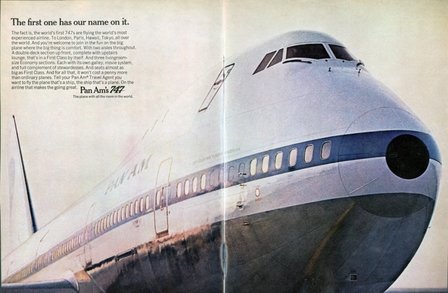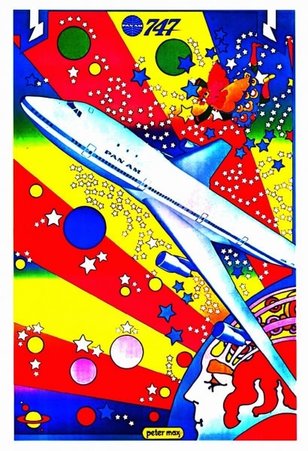"Being from a small town, the very idea of hundreds of people occupying the one plane landing before me, one that had just flown from the other side of the world, was then a wonderful one, in the true sense of the word." If my memory serves me correctly, I was visiting Sydney on a rare vacation at a southern seaside suburb when I first saw one of the early flights of a Pan Am B747-100 series jumbo jet on final landing approach to Mascot airport from QANTAS drive. Not long before, I had seen the moon landing on black & white TV in my small country town; and there was little degree of separation between them in terms of logistical inspiration. When I was some years younger, I had seen a Fokker Friendship (see video below) one night at a regional NSW airport. It was a thrilling encounter, to the point of it being frightening. This was especially so due to the extreme levels of noise to my young ears from the turboprop engines and the smell of kerosene. By the time I saw my jumbo jet, my earlier sense of fright had dissipated and these aircraft appeared almost serene, despite the high levels of noise. |
The noise of the Fokker...
 Image: www.panam.org
Image: www.panam.org
Being from a small town, the very idea of hundreds of people occupying the one plane landing before me, one that had just flown from the other side of the world, was then a wonderful one in the true sense of the word. Along those same lines, the very fact that Pan Am had called such planes their “Clippers” was both fitting and remarkable marketing.
I was never to get aboard one of those first series B747-100 passenger planes, but on several occasions I was in the jump seats and cabin on the full freighter 100 version. I could not afford to purchase a ticket in order to fly in such a plane until adulthood, but what I could do was to apply for a job in the international freight industry. I could also decide to work my tail off in order to learn, and then (by way of being productive) get ahead in that industry.
As my career flourished in international transport, so too did the proliferation of the Boeing “jumbo” into nearly all of the major air (trunk) routes of the world. Today, however, we are gradually seeing the B747 passenger planes being withdrawn from service.
www.bloomberg.com/news/articles/2017-01-11/united-s-747-retirement-plan-marks-end-for-iconic-jumbo-in-u-s
The above-linked announcement of United’s withdrawal is, for me, significant in that they had taken over Pan Am’s Pacific air routes upon the latter's demise. In fact, despite all the hard work, it had taken quite some time until I was offered my first business flight across the Pacific in the early-to-mid 80’s; and so it proved that I was to be flown by United on an ex-Pan Am long-range B747-SP. While the United attendants and cabin crew, might have been described as more than a little tired at the time, this plane’s performance envelope was still one to catch the imagination. The most significant thing about the shortened SP version of the B747 was that it had sufficient range to overfly Hawaii, and it allowed direct flight from Sydney to Los Angeles.
Flying a regular B747-200, or DC10, at that time (as I was to do more regularly) meant landing at an ungodly hour in the morning in Honolulu, recovering your luggage, waiting interminably until US Customs opened, and then confronting the said Customs officers before they had absorbed their first coffee of the morning. After many tortuous hours, you gained the "privilege" to recheck your luggage, and depart for the next intermediate US airport, where you would often have to again immediately transfer to a beyond location on a fully US domestic flight. Hence getting a B747-SP flight (see video in the end of this post), and being able to access a 75% agent discounted ticket from United, was a godsend!
I would go on to take several flights on the B747-SP, and even though I never got to fly to South Africa on one of the QANTAS planes of this model, I did once have an interesting flight into Sydney on Mandarin Airlines where the ex-Taiwanese air force pilot threw the shortened high performance version of the jumbo around like a sports car, as he tried to wipe off speed and extend time after having approached Sydney too quickly for air traffic control’s liking.
Before leaving the 200 series jumbo, I need to mention two very significant points. The first is that the 200 became the base load carrying aircraft for most long haul international routes where its range was often appropriate to the market. Without it my industry would not have grown the way it did, and my opportunities may well have been far more limited. The B747-200 was better for the cargo industry than later series planes principally because the shorter flight ranges available to passengers correlated with near-maximised cargo loads in most instances. In practice they were also to prove far less affected (in respect of cargo load-ability) than later B747 series by winds and full passenger/baggage loads on most of their scheduled sectors.
The other B747-200 series aircraft that was particularly important for the Australian market (for QANTAS who operated it, and for my career) was the B747-200 Combi. This aircraft’s main passenger deck was shortened, with the aft of the plane being occupied by freight that was loaded through a rear main-deck cargo door. The difference between able to load cargo with heights around 1.6me under-deck in the cargo holds, with that of over 2me on a main cargo deck of a B747 was profound.
The particular significance of the said B747-200 Combi aircraft for my employer at the time was the enabling of the carriage by air of tall mainframe computers, which was for us and many others, a key 1980’s market. At the time, the economics of running full freighter airliners, for those airlines operating on the Pacific runs in particular, would not have allowed them to serve the computer market as effectively as when the Combis were in service.
Alas, the downfall of the 200 series Combi was to be correlated with the firewall issues that were punctuated on 28 November 1987; when a South African Airlines 747- 200 Combi was lost over the Indian Ocean. While the Dutch and others flew some in later jumbo series, the Combi was never to be widely considered as effective in service again.
It was, however, to be the last of the “classic” jumbo’s, the B747-300, that was to prove to be my favourite of the overall series. Whether it was flying as a passenger with JAL across the Pacific, or with QANTAS on the Tokyo route, this aircraft just felt right for me on a seat-of-the-pants basis.
As for the B747-400, marking it as a "non-classic" of the series is appropriate as I see it. Upon launch as a passenger plane it failed its cargo load-ability test at anywhere near range at its maximum takeoff weight. It’s range performance simply didn’t meet Boeing’s sales pitch bought by the airlines that operated them.
When Boeing offered and delivered the extended range version of the B747-400 to QANTAS, their passenger management commercial decision was to consume the critical extra maximum take-off weight gained by immediately installing heavier on-board entertainment systems which, in turn, meant that direct flights to & from ports like Chicago and Dallas and the Australian East Coast became very marginal propositions for BOTH cargo and passengers. And yet, still we found cargo was sometimes pushed back by the pilots for US West Coast departing flights given adverse winds and high passenger loads.
The full cargo (or freighter version) of the B747-400 was ok, but it didn’t bring a lot extra to the table other than increased reliability & better fuel burn after they displaced the old-banger 100 and 200 series freighters that had been operating well past their used-by dates (to the point of the doors falling off!). Over the following decade it would be proved that the B747-400F's ultimately didn't pay their way.
The more recent B747-8F freighter has achieved a very limited number of orders and is to be the last of the jumbo series (if you exclude the troubled US Presidential plane project). As with the B747-400F, the lesser viability of new delivered freighters in the contemporary era is down to the proliferation of belly cargo space in the fast growing wide-body passenger aircraft market. In the latter case, if the cargo revenues derived from marketing from this passenger belly space do more than pay for the fuel, marketing/admin, and terminal costs, then they are contributing marginal returns to the overall airline operation.
Just as high value cargoes like mainframe computers have shrunk in physical size (and crucially in height), so too have many other tech devices. This means that demand for main deck cargo has ebbed in parallel with the new orders for the jumbo.
Perhaps the demise of the jumbo is fitting for the era, and perhaps too, new inspiration and concepts appropriate for a new era are overdue.
|
|
"... getting a B747-SP |





 RSS Feed
RSS Feed